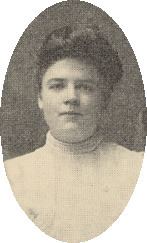Name Emily Butterfield Education Syracuse University | Role Architect | |
 | ||
Parent(s) Wells Duane Butterfield (father) and Helen Hossie Butterfield (mother) People also search for Edith MacConnel Hickok | ||
Emily Helen Butterfield (August 4, 1884, Algonac, Michigan – March 22, 1958, Neebish Island) was a pioneer in the Michigan women's movement.
Contents
- Early life
- Architecture
- The Detroit Business Womens Club and the BPW
- Greek activities
- Publications
- Art
- Retirement and death
- References
She was Michigan's first licensed female architect, one of the founders of the Alpha Gamma Delta sorority, active in Greek life, and a founding member of the Detroit Business Women's Club, the first professional women's club in the nation.
Early life
Butterfield was born in Algonac, Michigan, in St. Clair County, near Port Huron. She attended Detroit Public Schools. Butterfield and her father shared a great love of art. In her teenage years she and her father went on sketch trips to the western United States and Europe.
Architecture
Butterfield was accepted into the architecture program at Syracuse University in 1903. In 1907 she became the first licensed woman architect in the state of Michigan. With her father, she established the firm of Butterfield and Butterfield in 1917. The firm specialised in church architecture, and led the transformation of churches, especially Methodist, from Sunday meeting halls to centers of daily community and social activity. She practiced architecture in Detroit and Pontiac, planning 26 churches throughout the state as well as other buildings including factories, summer camps, stores, schools and homes.
The Detroit Business Women's Club and the BPW
The Detroit Business Women's Club, the first professional women's club in the nation, was started in 1912, by Butterfield (the first president), publisher Emma Spoor, and manufacturer's agent Grace Wright.
"I think it never occurred to us that we were doing something absolutely unique, I know I never would have had the idea if it had not been that all of my business acquaintances were men, and I was actually lonesome for speaking acquaintances with business women as I pattered up and down the avenue at the noon hour looking for a place where a lone woman might eat." Emily ButterfieldIn a series of mergers and assimilations, the Club became part of what is now known as BPW/Michigan, in turn a part of the oldest and largest organization for working women in the world, Business and Professional Women (BPW). The national BPW organization is made up of federations from each of the 50 states, the District of Columbia, Puerto Rico, and the Virgin Islands.
Greek activities
Butterfield was active in the college Greek movement. As an associate of the George Banta publishing company, Butterfield combined her design abilities and her knowledge of heraldry to design the coats of arms of several sororities and fraternities, among them her own ΑΓΔ coat of arms in the spring of 1906 as well as the coats of arms for Lambda Omega (later merged with Delta Zeta), Theta Phi Alpha, and Phi Beta sororities; she co-designed the Zeta Tau Alpha sorority coat of arms and the crest of Tau Kappa Epsilon.
Butterfield also designed the coats of arms for Alpha Kappa Psi, Sigma Delta Rho, Sigma Tau Gamma, Theta Upsilon Omega, and Theta Kappa Nu (later merged with Lambda Chi Alpha fraternities). With George Banta, she created the coat-of-arms (adopted in 1910) of Phi Mu Alpha Sinfonia Fraternity, the national fraternity for men in music.
She also designed the chapter houses for the Syracuse and Michigan State chapters of ΑΓΔ. When the fraternity established a summer camp (the "Alpha Gamma Delta Summer Camp Lodges") for underprivileged children in Jackson, Michigan in 1920, Butterfield was the architect of the camp and was camp manager until 1924. She served as editor of the Alpha Gamma Delta Quarterly, the fraternity publication, for 7 years.
Butterfield had a big impact on her fraternity and Greek life, as noted in the 2004 Alpha Gamma Delta Centennial Keynote Address:
"In the United States in 1900, three-quarters of the states forbade married women to own property in their name. In 1909, the members of Alpha Gamma Delta overlooked the statistic and planned ahead by starting a house fund in hopes of purchasing their own home. In 1928, they challenged the societal constraints once again by not only purchasing but building the first house — and we all know the name of the architect — Emily Helen Butterfield."Publications
Emily and her father also shared a love for, and studied the art of, heraldry, and she authored College Fraternity Heraldry in 1931. She published a children's book in 1933, Young People's History of Architecture, in which she used her illustrations from her many travels.
Art
Butterfield was an accomplished illustrator, working in pen and ink and watercolor, illustrating mainly nature, Michigan, and architectural scenes. She exhibited at the J. L. Hudson Gallery and at the Toledo Artists Club. Her artwork was used in her publications.
Retirement and death
Butterfield retired to Neebish Island, where she served as postmaster during World War II. She died on March 22, 1958 and was inducted into the Michigan Women's Hall of Fame for her work in the field of architecture in 1990.
